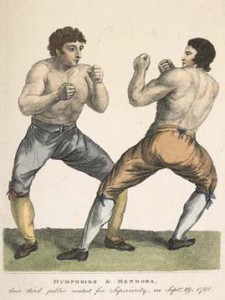Apr
10
The Return of Bart “Error-Man” Ehrman
Bible Under Attack by Skeptic Professor: Film at 11!
I think most of you probably know who Bart Ehrman is, right? He’s an agnostic, American New Testament scholar who has gained some popularity/notoriety over the past few years, writing & promoting books that purport to ‘correct’ the traditional, orthodox teachings and assumptions of Christianity. I’m not sure what his first popular book was, but a few that come to mind are Lost Christianities, Misquoting Jesus, and last year’s Jesus, Interrupted. And, every time Ehrman puts out something that takes more pot-shots at Christianity and the Bible, the skeptics get more material to throw at Christians and Christians get all worried and some start to lose their faith.
Why?
 Well, some Christians — and I’m talking about the genuine article, not just “cultural” Christians — have a shallow faith. Others, their “faith” may be strong but they don’t have a solid foundation for why they believe what they believe (other than a “spiritual experience”) or why the New Testament is to be trusted. Simply put, they haven’t done their homework. Most of us are guilty of that to some degree — yes, I include myself. Definitely. But, fears & doubts that flare up whenever someone like Ehrman puts out a new book and promotes it in on the airwaves should be a signal to Christians that they need a firmer grasp of the relevant disciplines (e.g., textual criticism, methodology of historical research, Church history, comparative religion, etc.). Not a college degree, mind you, but at least a basic understanding.
Well, some Christians — and I’m talking about the genuine article, not just “cultural” Christians — have a shallow faith. Others, their “faith” may be strong but they don’t have a solid foundation for why they believe what they believe (other than a “spiritual experience”) or why the New Testament is to be trusted. Simply put, they haven’t done their homework. Most of us are guilty of that to some degree — yes, I include myself. Definitely. But, fears & doubts that flare up whenever someone like Ehrman puts out a new book and promotes it in on the airwaves should be a signal to Christians that they need a firmer grasp of the relevant disciplines (e.g., textual criticism, methodology of historical research, Church history, comparative religion, etc.). Not a college degree, mind you, but at least a basic understanding.
You get the idea, so I’ll get off my soapbox. Anyway,…
Ehrman is a pretty lucid and enjoyable writer, and, from all reports, he’s a pretty congenial type in person, too. So, he doesn’t come off as quite as radical as, say, the Jesus Seminar guys, nor as mean or obnoxious as the so-called New Atheists (e.g., Dawkins, Dennett, Hitchens, & Harris) often do. He’s also a good speaker and knows how to add some shock-value to keep people intrigued. The media love him! And, since Ehrman is more likable, his claims become that much more palatable to the uninformed, Christian and non-Christian.
A few weeks ago, Ehrman published his most recent tome: Forged: Writing in the Name of God–Why the Bible’s Authors Are Not Who We Think They Are. In it, he proceeds to explain that not only were literary forgeries abundant in the ancient world (no argument there), including some by ‘Christians’ (unfortunately, also true), but — here it comes… — about 70% of the New Testament books are also forgeries. That is, they were not written by the people whose names they bear or are otherwise traditionally attributed as the authors. Thus, we don’t have the eyewitness accounts or apostolic teachings that we thought we had. Are they still authoritative? If they aren’t authoritative — and maybe their general, historical reliability is in question, too — then we can’t legitimately consider them inspired or worthy of being canon, can we?
A couple of points before we proceed…
Ehrman explains that what he considers to be a forgery, or pseudepigrapha (“false writing”), is anything that claims to be written by a known figure who did not in fact write it. (Makes sense.) He believes that some forged letters attributed to Peter and Paul made it into the New Testament — namely, I & II Peter, Ephesians, Colossians, II Thessalonians, I & II Timothy, and Titus. Uh-oh!
There is another definition that needs to be addressed in Ehrman’s work. As with many skeptics, he takes anybody who call themselves “Christian” to be a… Christian. They can hold fully Gnostic or any other heretical views, but to him they are “Christian”. This is because Ehrman is of the school of thought (see his book Lost Christianities) that there is no one, truly orthodox Christian doctrine; rather, there were many, equally valid “Christian” traditions. The one that survived today (though in several branches and denominations) did so simply by its adherents winning a power struggle. Keep that in mind when you hear Ehrman and others talk about early Christianity and Christian doctrine.
Of course, the issue of authorship is nothing new and was a BIG deal for the early Church, too. It was the primary criterion for determining which books ended up in the official canon back in the 4th century. To be sure, the evidence for the traditional authorship varies in strength for each of the 27 New Testament books. But, this was definitely a concern for the early Church Fathers. A few books were debated back & forth before being accepted (e.g., Hebrews, II Peter, James, Revelation). Others were deemed to be forgeries or apocryphal. Still others fell somewhere in between, from “well-accepted” to “spurious”. A book’s pedigree had to be pretty darn good for it to be ultimately accepted as canonical.
In some cases, we have writings from the early Church Fathers that describe the circumstances around when certain N.T. books were written. For example: Polycarp, bishop of Smyrna, was the direct disciple of the Apostle John. Polycarp’s associate Papias (c. AD 120 or earlier) and Polycarp’s own student, Irenaeus (c. AD 180), both provide information about the origins of the Gospels. Here’s what Papias said:
“Mark, having become the interpreter of Peter, wrote down accurately, though not indeed in order, whatsoever he remembered of the things said or done by Christ. For he neither heard the Lord nor followed him, but afterward, as I said, he followed Peter, who adapted his teaching to the needs of his hearers, but with no intention of giving a connected account of the Lord’s discourse, so that Mark committed no error while he thus wrote some things as he remembered them. For he was careful of one thing, not to omit any of the things which he had heard, and not to state any of them falsely…. So then Matthew wrote the oracles in the Hebrew language, and every one interpreted them as he was able.”
Around AD 95/96 Clement of Rome wrote a letter to the Corinthian church, quoting from 10 different N.T. books. According to Eusebius, Clement also wrote about Mark’s writing and Peter’s blessing of it. Apparently, Peter’s followers were so hungry for his teaching, they begged and pleaded with Mark, “that he would leave them a written monument of the doctrine which had been orally communicated to them.” He finally relented, resulting in the document known as the Gospel of Mark. When the Holy Spirit revealed all of this to Peter, he “was pleased with the zeal of the men, and that the work obtained the sanction of his authority for the purpose of being used in the churches.”
Some things are debated among scholars, such as whether Mark’s gospel was the first written or Matthew’s, what their respective sources were, and whether the first copies of the latter were in Hebrew, Aramaic, or Greek. But, hardly anyone disputes the authorship of the books, since the early Church Fathers seemed pretty sure. To claim otherwise, one must come up with a more convincing counterargument to explain how & why the Fathers were either deceiving others or had themselves been duped.
In the above case, the resulting work was named after the actual writer, Mark, rather than Peter. But, it leads to the point that, like some writers today, it was not uncommon for writers in the ancient world — this would apply to both Old & New Testament eras — to have a secretary/assistant (i.e., a junior disciple or acolyte) do the actual writing for them. One might even have more than one secretary/assistant over the years. This might account for certain differences from one epistle/book to another, even though the primary source of the material was a particular apostle or prophet who was considered the author. For example, we know that Paul had Tertius transcribe the letter to the Romans for him. (Rom. 16:22) It is also widely believed that Timothy or another companion sometimes took dictation from Paul, perhaps because of a vision problem or some other affliction. But, Paul usually wrote a short note in his own hand as proof that the epistle was from him (e.g., II Thess. 3:17). More on this later…
 So, what is Ehrman’s beef? And, what is his modus operandi?
So, what is Ehrman’s beef? And, what is his modus operandi?
In a recently released review of Forged, New Testament scholar, author, and apologist Mike Licona shed some light on Ehrman’s methodology….
Rather than accepting the traditional arguments for authorship unless and until a stronger case can be made against them, Ehrman prefers to assume they’re all forgeries until a practically bulletproof counterargument can be presented to change his mind. This can be seen when he uses surprisingly weak arguments for his forgery theories or he quickly dismisses the evidence for traditional authorship.
Ehrman tends to ignore the legitimacy of certain writing conventions in the Greco-Roman world, e.g., time-compression and the importance of narrative flow.
Ehrman also leaves out certain important information. For instance, after discussing some ancient forgeries and their subjects, he rightly states that “The authors intended to deceive their readers, and their readers were all too easily deceived.” However, none of those discussed were accepted into New Testament canon — a detail he conveniently forgets.
As Licona notes,
“Many of the teachings in the disputed letters of Paul that Ehrman regards as contradictory to the teachings in his undisputed letters are solved just as easily with a careful look at the texts in question. Unfortunately, because many of Ehrman’s readers will go no further than reading Forged, they will fall prey to some very poor arguments.”
In addition, Licona points out that Ehrman makes a big mistake when he claims that there was “no attempt throughout the [Roman] empire to stamp [Christianity] out” for its first 200 years. How could he have overlooked Nero’s diverting blame from himself to the Christians for the burning of Rome in AD 64? According to Tacitus, Nero rounded up, mocked & debased, questioned, tortured, and brutally executed Christians for this, making a big spectacle of it all. We also know from the writings of Pliny the Younger, a Roman magistrate, that he arrested, questioned, and executed anyone in his jurisdiction that refused to deny Christ. Could Professor Ehrman be ignorant of all this, or did it conveniently escape his memory while writing the book?
Ehrman contends that the Book of Acts and the Epistle of James are forgeries, too.
“One of the reasons Ehrman regards Acts as a forgery is because he sees contradictions between how the relationship between Peter and Paul are presented in it and how Paul speaks of Peter in his undisputed letters. For example, in Acts, Peter and Paul are ‘completely aligned in every respect’ (204). In fact, when it came to accepting the Gentiles as brothers in Christ and eating with them, Peter received a revelation of this even before Paul. (This is not actually true. According to Acts 9-10, Peter’s revelation occurred after Paul’s conversion. And it was made known at the time of Paul’s conversion experience that God was sending him to the Gentiles [Acts 9:15; cf. 22:21].) However, in Galatians 2:11-14 (an undisputed letter), Paul tells us that he opposed Peter to his face when he withdrew from eating with Gentiles (204). Ehrman recognizes there are ways of reconciling these differences. But he extends no charity in such an exercise.
‘One could argue that Paul was right, that Peter was simply being hypocritical. But there is nothing in Galatians to suggest that Peter actually saw it this way or that he thought Paul was right about the matter (204).’
There is also nothing in Galatians to suggest that Peter did not see it this way or that he thought Paul was wrong about the matter. Reconciling Galatians with Acts in this case is quite easy. But Ehrman will have none of it. Could it be because it would throw a wrench in his views?”
Ironically, in arguing for James being a forgery, he counts on facts established in the book of Acts. I guess even a forgerer gets some facts straight; fortunately, they are the ones Ehrman needs to make a point. (Though, Licona successfully refutes that argument, too.)
Now, let’s return to the matter of using secretaries/assistants to help write a letter. Ehrman recognizes Paul’s use of secretaries for some of his letters. He even admits,
“Virtually all of the problems with what I’ve been calling forgeries can be solved if secretaries were heavily involved in the composition of the early Christian writings.”
But, he rejects the idea that such secretaries might have been used for anything beyond taking straight dictation — e.g., correcting grammar, improving style, contributing content, or composing a letter for his boss to sign off on. His reasons are threefold: 1) Only the very wealthy did this, due to the costs involved in producing documents. 2) Unlike the disputed N.T. letters, letters in the Greco-Roman world were quite short and did not deal with complex issues. 3) While evidence suggests that short documents like land deeds and sales receipts were handled by secretaries, “absolutely no evidence” supports the contention that secretaries were authorized to compose “a long, detailed, finely argued, carefully reasoned, and nuanced letter like 1 Peter or Ephesians” (137). Further, Ehrman claims that someone like Peter — the ancient equivalent of a redneck lout — couldn’t have had anything to do with the eloquently argued and presented epistle known as I Peter, even with the help of a secretary.
Licona, however, counters each of these easily as follows:
1) We know from Paul’s undisputed letters that he got financial backing from various churches. We know he had co-workers who not only wrote but carried his letters for him. (Couriers would otherwise have been a big cost.) And nothing precludes the idea of his secretaries or other co-workers lending more editorial assistance or suggestions to polish up Paul’s writing. We don’t know one way or the other, but lack of wealth was likely not a limiting factor.
2) Except for the brief letter to Philemon, all of the undisputed letters of Paul are just as long and complex in content. In fact, the average length of the undisputed letters is longer than the average length of the disputed ones. All but three are within the range of lengths for the letters of Cicero and Seneca. This argument commits suicide.
3) Regarding the comparative length issue, Ehrman himself says on the previous page, “So evidence that derives from the brief, stereotyped letters typically found in Greek and Roman circles is not necessarily germane to the ‘letters’ of the early Christians” (136). So, which is it, Bart? Plus, Lucian (2nd c.) tells us that an ancient historian, when tasked with reproducing a speech, say, from eyewitness accounts, was expected to use accurate content, yet he could employ his own style & flare when communicating that content. The same sort of thing may have been in play when Peter’s epistles were written.
Personally, I don’t really have a problem with the Apostles or anyone else using secretaries to help compose a clear and accurate account of… whatever. As long as the bulk of the content comes from the one attributed as author, I’m OK with that. Apparently, so were the early Church Fathers and most other church historians and theologians who were acquainted with the idea.
In the end, according to Licona, Ehrman’s new book is typically engaging and terrific at introducing the authorship issue to a lay audience. But, it — rather, its author — is also guilty of misleading the reader, of being inconsistent and unreasonable in its reasoning, and of giving poor arguments against the traditional views. Nothing to worry about here, folks!
P.S. I wonder how strong the evidence is that Bart D. Ehrman actually wrote the book known as Forged.

















